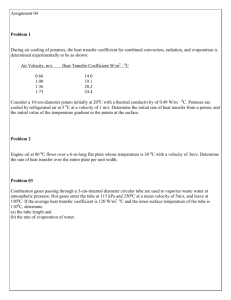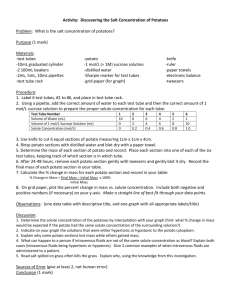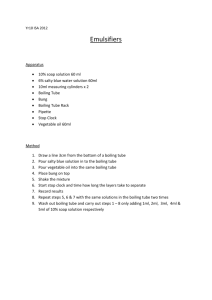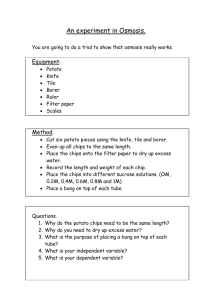diffusion.doc - Spolem.co.uk
advertisement
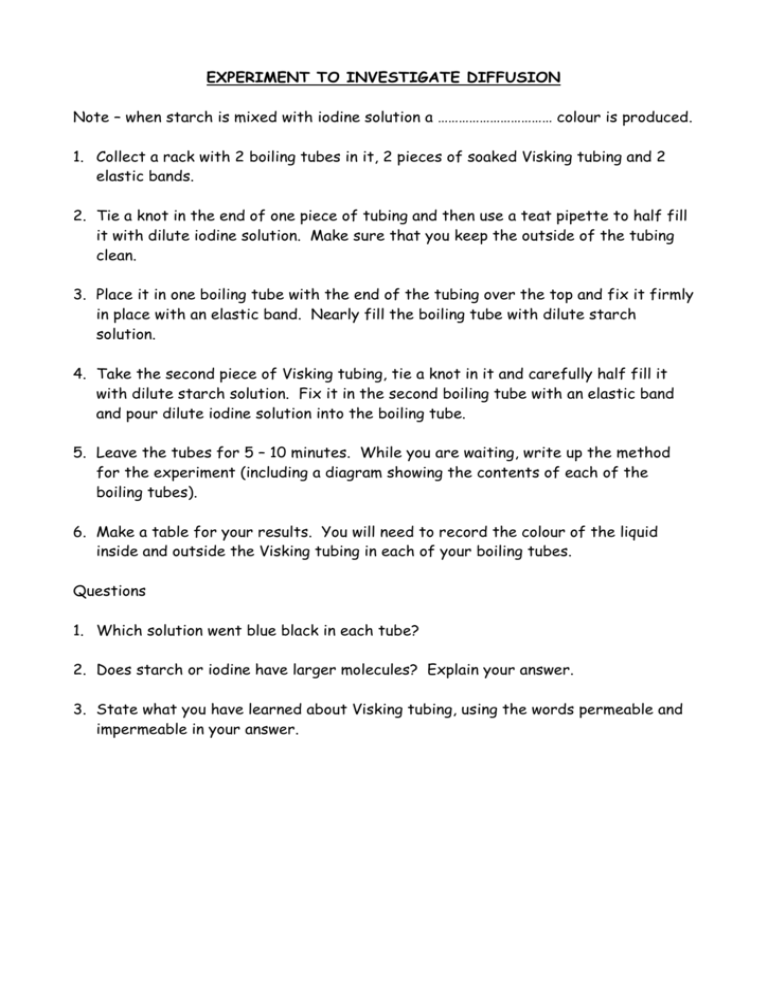
EXPERIMENT TO INVESTIGATE DIFFUSION Note – when starch is mixed with iodine solution a …………………………… colour is produced. 1. Collect a rack with 2 boiling tubes in it, 2 pieces of soaked Visking tubing and 2 elastic bands. 2. Tie a knot in the end of one piece of tubing and then use a teat pipette to half fill it with dilute iodine solution. Make sure that you keep the outside of the tubing clean. 3. Place it in one boiling tube with the end of the tubing over the top and fix it firmly in place with an elastic band. Nearly fill the boiling tube with dilute starch solution. 4. Take the second piece of Visking tubing, tie a knot in it and carefully half fill it with dilute starch solution. Fix it in the second boiling tube with an elastic band and pour dilute iodine solution into the boiling tube. 5. Leave the tubes for 5 – 10 minutes. While you are waiting, write up the method for the experiment (including a diagram showing the contents of each of the boiling tubes). 6. Make a table for your results. You will need to record the colour of the liquid inside and outside the Visking tubing in each of your boiling tubes. Questions 1. Which solution went blue black in each tube? 2. Does starch or iodine have larger molecules? Explain your answer. 3. State what you have learned about Visking tubing, using the words permeable and impermeable in your answer. Experiment 2 – Potato Potato cells contain cell sap, which is made up of a mixture of mineral salts and sugars dissolved in water. 1. Label 3 boiling tubes A, B and C. 2. Into tube A put 20 cm3 of strong sugar solution (using a syringe). 3. Into tube B put 10 cm3 of strong sugar solution and 10 cm3 of water. 4. Into tube C put 20 cm3 of water (make sure that the syringe is clean!). 5. Use the cork borer to make 9 pieces of potato. These need to be exactly the same length (about 4 cm), with no skin. Write down how long they are at the start of the experiment. BE CAREFUL WHEN USING THE BORER THAT YOU DON’T PUSH IT STRAIGHT THROUGH THE POTATO INTO YOUR HAND! 6. Put 3 or each potato bores into each tube and leave in a rack until next lesson (make sure you know which is yours!). Prediction – you have made up three solutions. A is a strong sugar solution, B a weak sugar solution and C is water. Thinking about osmosis and how water moves, what do you think will happen to the length of each set of potato bores? Potato experiment - Next lesson Take out the potato bores from each tube, dry them with a paper towel and measure their length. In your book: write your method (including a diagram). write down your prediction from last lesson. for your results, copy and complete the following table. For the length section, you need to take the AVERAGE length of your 3 pieces of potato. TUBE A SUGAR SOLUTION strong B weak C water LENGTH for your conclusion, answer the following questions. a) b) c) d) e) f) g) In which tube had the potato increased the most in length? Explain why. In which tube had the potato decreased the most in length? Explain why. In which tube had the potato changed the least? Explain why. Why did you use 3 cylinders in each tube? Why did you take the average change in length? Why did you use the same volume of water in each tube? Can you think of any way that you could improve your experiment to make it more accurate?
